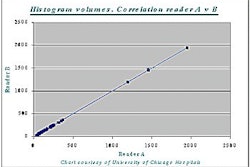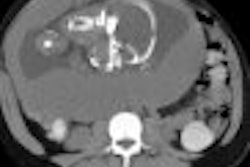SAN ANTONIO - A negative finding on CT angiography (CTA) of suspected pulmonary embolism appears sufficient to rule out further treatment in these patients, researchers from Australia reported at the scientific meeting of the Society of Cardiovascular and Interventional Radiology Wednesday.
Dr. Jacques Olivier of Gold Coast Hospital, Southport, Queensland, reviewed the treatment of more than 1,000 consecutive patients who were admitted to the hospital suffering from suspected pulmonary embolism (PE) during a 39-month period beginning in January 1996.
Helical CTA was performed and if the scan proved positive, the patient went on to treatment with anticoagulants. Treatment was withheld if the test results were negative, Olivier said.
Of the 1,039 patients, 730 had negative CTA and 11.6% (84) died within six months of the test. Two independent reviewers who were asked to determine if PE could have caused the deaths. If either reviewer thought that was the case, the scan results were considered false negative.
CTA was judged falsely negative in six of the cases, a finding that made his hospital staff confident in the CTA results, Olivier said.
"That represented 0.8% of the study group and 7% of the deaths," he said. "We felt that if we had missed a significant number of pulmonary embolisms, we would have had a much higher death rate.
Olivier said that even in the six false negative cases, four of the patients were over 85-years-old. He also noted that of the 1,039 patients in the study, only 17 patients were lost to follow-up, and the average age of those patients was around 40.
"This large series illustrates that favorable clinical outcome with respect to recurrent pulmonary embolism usually follows a negative pulmonary PTA," Olivier said
Olivier said the study added greater weight to the sensitivity of CTA to detect threatening emboli, and it also suggested that small emboli might not be as important in determining patient outcome in pulmonary embolism cases.
"This series suggests that withholding anticoagulants after a negative pulmonary CTA is relatively safe," he said.
In a response to the study, Dr. Donald Denny Jr. said the acceptance of CTA would depend on the sensitivity of the procedure.
"It would appear, based on Dr. Olivier and other work published in the last year, that CTA has a high sensitivity in this diagnosis," said Denny, who is an assistant clinical professor of diagnostic radiology at the Yale University School of Medicine in New Haven, CT.
In addition to being able to rule out PE as the cause of a patient's discomfort, Denny said that CTA also might be able to discover the true cause of the problem. Advantages of the procedure include the fact that it is not operator dependent, devices are widely available, and the modality produces a rapid result.
However, there are "still important issues that need to be resolved in determining whether we can depend upon CT pulmonary angiography in pulmonary embolism," he said, including field-of- view, scanning speed, and the use of nonionic contrast agents. Cost-effectiveness is an issue as well, Denny added.
"I suspect that if it does successfully replace other noninvasive imaging, we will find that CT has the ability to save money," he said. "A negative CT appears to be highly predictive of the absence of death by pulmonary embolism within a three to six month follow-up period. More work need to be done to define the role of this promising technique."
By Edward SusmanAuntMinnie.com contributing writer
March 9, 2001
Related Reading
Spiral computed tomography effectively rules out pulmonary embolism, February 12, 2001
Click here to post your comments about this story. Please include the headline of the article in your message.
Copyright © 2001 AuntMinnie.com



















